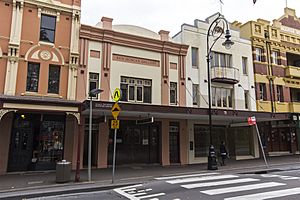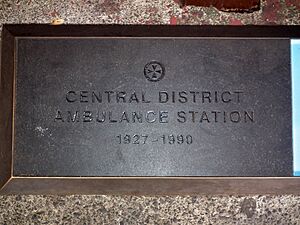Old Ambulance Station, The Rocks facts for kids
Quick facts for kids Old Ambulance Station, The Rocks |
|
|---|---|

The former ambulance station and now Ken Duncan Gallery, pictured in 2014
|
|
| Location | 73 George Street, The Rocks, City of Sydney, New South Wales, Australia |
| Built | 1842–1843 |
| Architect | Howie Moffot & Co (1927-8 front facade) |
| Architectural style(s) | Victorian Georgian |
| Owner | Property NSW |
| Official name: Shop, Ken Duncan Gallery; Ambulance Station | |
| Type | State heritage (built) |
| Designated | 10 May 2002 |
| Reference no. | 1589 |
| Type | Ambulance Station |
| Category | Health Services |
| Lua error in Module:Location_map at line 420: attempt to index field 'wikibase' (a nil value). | |
The Old Ambulance Station, The Rocks is a historic building in The Rocks, a famous area in Sydney, Australia. It used to be an ambulance station and a public house (like an old hotel or pub). Today, it is the main office for The Argyle Network, a company that helps people find jobs in technology.
This building is located at 73 George Street. It was built a long time ago, between 1842 and 1843. Later, in 1927-1928, its front look (called the facade) was updated by architects Howie Moffot & Co. The building is also known as the Former Central District Ambulance Station and the Ken Duncan Gallery. It is owned by Property NSW, which is a part of the Government of New South Wales. Because of its long history, it was added to the New South Wales State Heritage Register on May 10, 2002.
Contents
A Look Back: The Building's History
The land where the Old Ambulance Station stands was once part of Sydney's very first hospital site. In 1838, the land was given to William Carr and George John Rogers. Later, in 1842, a man named Frederic Wright Unwin sold a piece of this land to Matthias Hooper.
From Pub to Hotel: Early Days
Matthias Hooper built a public house on the land in 1842-1843. It was called the "Kings Head." This building had three floors and ten rooms. It was made of brick with a slate roof and was described as having "every convenience." Hooper ran the "Kings Head" until 1849.
Over the years, the building changed owners and names several times. In 1874, Joseph George Raphael changed its name to the "Great Pacific Hotel." Around 1870, stone walls were built around the property. In 1885, it became the "P & O Hotel."
New Uses: Salvation Army and Ambulance Service
In 1900, the NSW Government took over the property. The P&O; Hotel stayed open until at least 1909. From 1911 to 1927, The Salvation Army used the building as a home for military and naval personnel.
In 1927, big changes were made to the building. Howie Moffot & Co. designed a new front for it. In 1928, after these updates, the Central District Ambulance Service started using the building as their depot for the Circular Quay area.
Training and Museum: Ambulance Station Years
In 1950, the Housing Commission was in charge of renting out the building. In 1971, the upstairs rooms were updated. They were used for training new ambulance recruits. These classes stopped in 1973 when training was moved to the NSW Ambulance Board.
In the mid-1980s, there was an idea to create an Ambulance Service Museum in the building. For a while, some old ambulances were even on display there.
Modern Times: Gallery and Business
By late 1990, the building needed major repairs. It was found to have white ants, and the floors were not safe. So, the ambulance service moved out on November 9, 1990.
From 2008 to 2018, the building was home to the Ken Duncan Gallery, a famous photography gallery. After that, it became the main office for The Argyle Network, a technology recruitment business from Australia.
What the Building Looks Like
The Old Ambulance Station at 73 George Street North is a two-story building made of stone and brick. It also has a cellar (a basement). The back of the building used to have a sandstone wall, but that has been removed. The building once stretched all the way from George Street to Kendall Lane at the back.
The roof is made of corrugated iron and is hidden from George Street by decorative walls called parapets. The front of the building, updated in 1928, shows a style called Art Nouveau. Inside, the first floor has timber floors and ceilings made of pressed metal.
Why This Building is Important
The Old Ambulance Station is very important to the history and culture of New South Wales. It's special because it still has many parts of the original building from 1842. It might even be the oldest hotel building still standing in The Rocks area!
The stone and brick walls at the back of the property are also very old, dating back to the mid-1800s. They show how the hotel's yard changed over time. The building's size and look still add a lot to the historic feel of George Street.
A Changing Story: Different Uses Over Time
This building has had many different uses throughout its long life. Its time as a hotel is especially important. It shows how the area changed, as The Rocks once had many public houses. This highlights how important drinking places were to the local economy back then.
The way the building was built shows how buildings were made in the 1800s. It also shows the improved standards for hotels around 1840. The site has connections to the very first hospital in the colony from 1788. It's also linked to important historical figures from the 1800s, like Surgeon William Balmain and Frederic Unwin.
Beautiful Design: Architectural Significance
The later Art Nouveau front of the building, added in 1928, is very detailed and well-designed. It's a great example of how an old hotel building was updated to become a modern utility building. The way it looks, its size, and the materials used make George Street look very historic and rich in character. Many nearby buildings in The Rocks from the 1920s and 1930s share a similar style, adding to this unique look.
Community Connections: Social Importance
The building's use as an early public house from 1842, with "every convenience," is very important to the history of The Rocks and Sydney. Its time as The Salvation Army, Naval and Military Home from 1911 to 1927 is also significant. The change to an Ambulance Station in 1927 further shows its importance to the community.
Learning from the Past: Research Potential
The building's construction, with its sandstone basement and three-story brick structure, can teach us about early building methods. The sandstone walls that support the brick walls above show an important old way of building. The changes made in 1927, which transformed the front into a modern style, also offer insights into architectural history.


